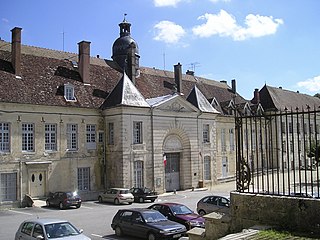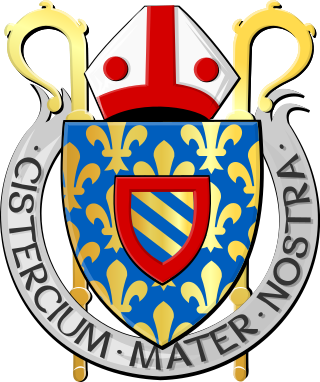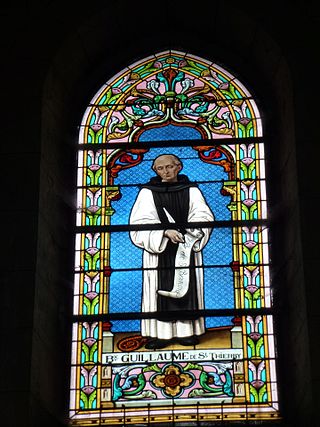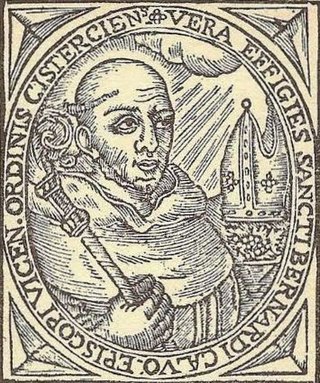Saint Bernard of Valdeiglesias | |
|---|---|
| Died | c. 1155 |
| Venerated in | Roman Catholic Church |
| Feast | 20 August |
| Patronage | Candeleda, Spain |
Bernard of Valdeiglesias (or "of Candeleda") was a Benedictine Cistercian monk at Valdeiglesias, province of Avila, Spain.
Bernard joined the Cistercians in 1177. [1] He was sent with a group of other monks to establish a monastery at Grandassilva in Estremadura, which effort failed when the community was devastated by the plague.
He is Patron saint of Candeleda, Spain, and is invoked against rabies. [1]

Bernard of Clairvaux, O. Cist., venerated as Saint Bernard, was an abbot, mystic, co-founder of the Knights Templars, and a major leader in the reformation of the Benedictine Order through the nascent Cistercian Order.

Clairvaux Abbey was a Cistercian monastery in Ville-sous-la-Ferté, 15 kilometres (9.3 mi) from Bar-sur-Aube. The original building, founded in 1115 by St. Bernard, is now in ruins; the present structure dates from 1708. Clairvaux Abbey was a good example of the general layout of a Cistercian monastery. The abbey has been listed since 1926 as a historical monument by the French Ministry of Culture.

Cîteaux Abbey is a Catholic abbey located in Saint-Nicolas-lès-Cîteaux, south of Dijon, France. It is notable for being the original house of the Cistercian order. Today, it belongs to the Trappists.

The Cistercians, officially the Order of Cistercians, are a Catholic religious order of monks and nuns that branched off from the Benedictines and follow the Rule of Saint Benedict, as well as the contributions of the highly-influential Bernard of Clairvaux, known as the Latin Rule. They are also known as Bernardines, after Saint Bernard himself, or as White Monks, in reference to the colour of the "cuculla" or cowl worn by the Cistercians over their habits, as opposed to the black cowl worn by Benedictines.
Cristóbal de Castillejo was a Spanish poet, a contemporary of Garcilaso de la Vega and Juan Boscán, who championed the use of traditional forms of Spanish poetry and criticized the use of Italianate forms such as the sonnet.

Cistercian architecture is a style of architecture associated with the churches, monasteries and abbeys of the Roman Catholic Cistercian Order. It was heavily influenced by Abbot Bernard of Clairvaux, who believed that churches should avoid superfluous ornamentation so as not to distract from prayer. Cistercian architecture was simple and utilitarian. Although a few images of religious subjects were allowed, such as the crucifix, elaborate figures common in medieval churches were prohibited. Bernard noted their capacity for distracting monks in a famous letter. Early Cistercian architecture shows a transition between Romanesque and Gothic architecture. Later abbeys were constructed in Renaissance and Baroque styles, which were more ornate by nature.

Mount St Bernard Abbey is a Roman Catholic, Trappist monastery near Coalville, Leicestershire, England, founded in 1835 in the parish of Whitwick and now in that of Charley. The abbey was the first permanent monastery to be founded in England since the Reformation and is the sole Trappist house in England. The monks brew the only Trappist beer in Britain.

St. Bernard de Clairvaux Church is a medieval Spanish monastery cloister which was built in the town of Sacramenia in Segovia, Spain, in the 12th century but dismantled in the 20th century and shipped to New York City in the United States. It was eventually reassembled at 16711 West Dixie Highway, North Miami Beach, Florida, where it is now an Episcopal church and tourist attraction called Ancient Spanish Monastery.

The Abbey of Fontenay is a former Cistercian abbey located in the commune of Marmagne, near Montbard, in the département of Côte-d'Or in France. It was founded by Saint Bernard of Clairvaux in 1118, and built in the Romanesque style. It is one of the oldest and most complete Cistercian abbeys in Europe, and became a UNESCO World Heritage Site in 1981. Of the original complex comprising church, dormitory, cloister, chapter house, caldarium, refectory, dovecote and forge, all remain intact except the refectory and are well maintained. The Abbey of Fontenay, along with other Cistercian abbeys, forms a connecting link between Romanesque and Gothic architecture.

William of Saint-Thierry, O. Cist was a twelfth-century Benedictine, theologian and mystic from Liège who became abbot of Saint-Thierry in France, and later joined the Cistercian Order.
Crisóstomo Henríquez was a Spanish Cistercian monk and ecclesiastical historian, who belonged to the Spanish congregation of that order, and who worked in the Spanish Netherlands.

Cistercian nuns are female members of the Cistercian Order, a religious order belonging to the Roman Catholic branch of the Catholic Church.
Peter, usually known as Peter of Tarentaise, was a Cistercian monk who served as the archbishop of Tarentaise from 1141 until his death.

Hugh of Noara or of Novara, also known as Ugo of Novara and Hugo of Novara, was a Cistercian monk and a disciple of Bernard of Clairvaux. French by birth, he served as the first abbot of Novara Abbey, Sicily, where he remained until his death in 1170.

Pelayos de la Presa is a municipality in the Community of Madrid, Spain. It covers an area of 7.58 km2. As of 2018, it has a population of 2,475.

The Abbey of Santa Maria di Rovegnano is a Cistercian monastic complex in the comune of Milan, Lombardy, northern Italy. The borgo that has developed round the abbey was once an independent commune called Chiaravalle Milanese, now included in Milan and referred to as the Chiaravalle district.

Bernat Calbó (or Calvó) (c. 1180 – 26 October 1243), sometimes called Bernard of Calvo, was a Catalan jurist, bureaucrat, monk, bishop, and soldier.

The Monastery of Pelayos is a Cistercian monastery in a state of ruin located in Pelayos de la Presa, Community of Madrid.